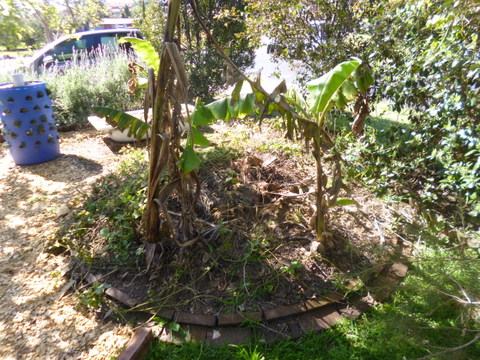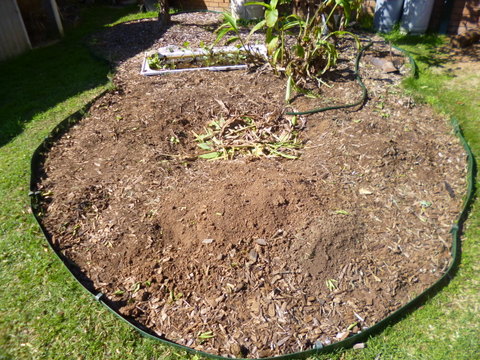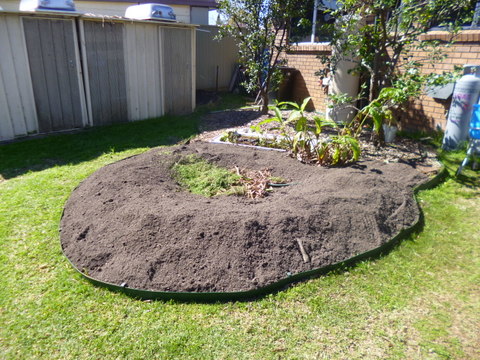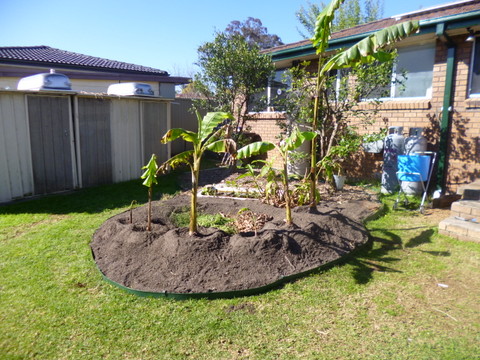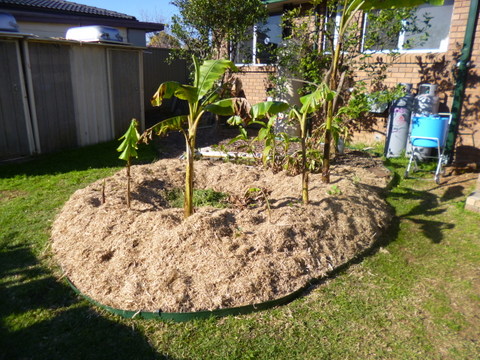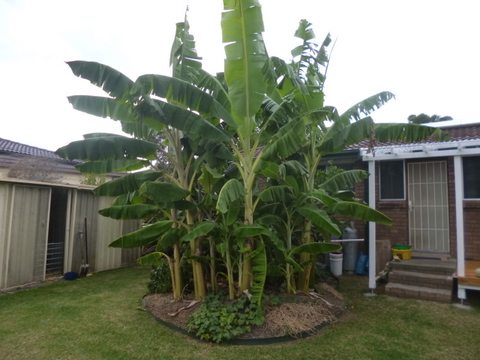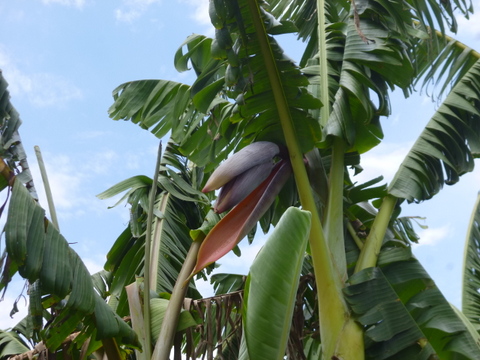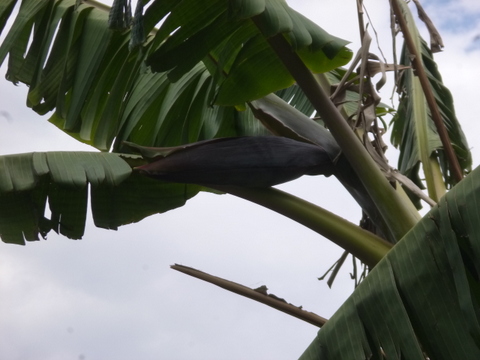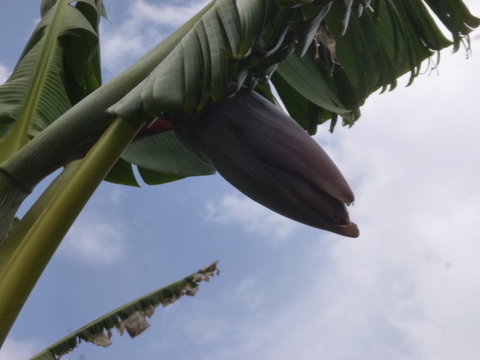I think the idea of a banana circle is great! Dig a hole, mound up the dirt from the hole around edge of the hole and plant bananas, then add organic materials into the centre hole to rot down and feed the bananas. It makes sense to me, so when we had our local permaculture group offer to build one yonks ago, I said yes! Unfortunately, when they asked where to put it I only had a few minutes to come to that decision…….. and I got it wrong!
This is where planning comes in. It was the wrong place for a number of reasons –
• Fruiting plants benefit from full sun, especially the sub-tropical banana and where I had located the circle it was shaded by the mulberry tree on the west, the bay tree to the north, and the melaleuca trees to the east. It got some sun, but not as much as it needed, particularly in summer when the mulberry tree really leafed out.
• The soil was crap! The soil dug out of the hole was mostly clay with a bit of topsoil and organic matter thrown in. The rain ran off the dry clay but if the rain went on for any length of time there was a chance of waterlogging. Not the best soil in the world to plant the bananas directly into.
• Bananas need lots of water, and a great way of providing that water is with grey water. Unfortunately the banana circle was in the front yard, while all the greywater pipes exited the house around the back. To make use of this greywater I would need to catch it and pump it around the front, which required an input of energy. While I had several ideas of how to do this, there always seemed to be greater priorities so it never happened.
Needless to so say, as a result of the above, I never got one single banana of any of the banana trees in the 6 or 7 years that the circle was in operation. However, I did plant some sweet potatoes in the circle and they continue to do quite well.
Plan B
I have been thinking for some time that I should relocate the banana circle to the back yard, which is more open, has better soil and (you guessed it!) waste water outlets. I had tentatively identified an area which currently held a very sorry specimen of a lemonade tree, which wasn’t happy in its current position. Also, spring was rapidly approaching and any moving of plants would need to be done in the very near future. Everything came together last weekend.
We get together with permaculture friends once a month to help each other out with tasks which are quicker and easier when done by a group (see “the pod”) and we were due for our turn last weekend.
We got together and pruned the lemonade tree back pretty heavily and then dug it out by digging around the bottom of the tree then levering it over to break of any adhering roots. There was no place for it here so I gave it to one of our pod-mates who has more land than we do.
This left the area where the tree was cleared and with a hole already in place. Unfortunately I had forgotten this and although the soil was better, there wasn’t enough of it to make an effective mound so I had to order in a cubic metre of organic soil mix from a local supplier. One disadvantage of the suburban block is that there is not much unused organic matter lying around.
I barrowed the mix around the back and used it to form a mount on the south side of the hole, tapering down closer to the grown on the northern side, my idea being to curve the bananas around to form a crescent shaped sun trap. The sun trap has foliage to the south and is open to the north to make the most out of the northerly winter sun.
I removed the bananas from the circle in the front yard, keeping as much root material as I could manage and cut any daughter plants away to be planted separately, and leaving the sweet potatoes as undisturbed as possible. I dug a hole into the mound for each banana and tossed in some chook poo for nitrogen and wood ash for potassium, covered it with some mix, then planted each of the bananas. To make sure the bananas were able to make use of any rainwater I formed a ring of organic mix around each one. This effectively made a basin around the base of each one to retain the water and allow it to sink in, rather than running straight off the mound.
With all of this work done I mulched the whole mound with sugar can mulch and tossed some organic matter into the hole to start decomposing. On the northern side of the mound I had intended to plant some low growing food plants and decided on a series of capsicum and chilli plants. I also intend to put some flowering edibles in to attract beneficial insects and improve biodiversity of the area. I had some nasturtium seedlings I had raised, so they were the start.
If you intend to put in a banana circle (or anything else for that matter) it pays to have a think about what you are trying to achieve and how you will go about it, before starting. A little planning goes along way!
2016 Update
After less than 12 months, the banana circle looks like this!
And further on, a bit less than 18 months later, we have not 1, not 2, but 3 banana plants with flowers on them! It has been amamzing to watch the transformation, from weedy little banana plants to huge and vigorous ones. I am sure that the extensive amount of water they get from our spa/bath/shower area is the main reason why they are doing so well now compared to when they were in the front yard.



